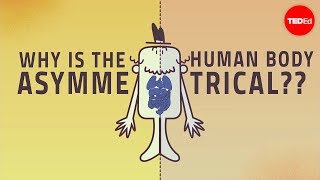(单词翻译:单击)
Symmetry is everywhere in nature, and we usually associate it with beauty:
对称性在大自然中随处可见,并且我们往往将对称与美联系起来:
a perfectly shaped leaf, or a butterfly with intricate patterns mirrored on each wing.
一片完全对称的叶子,或者一只拥有对称且花纹复杂翅膀的蝴蝶。
But it turns out that asymmetry is pretty important, too, and more common than you might think,
但是事实上,不对称的现象也是十分重要的,并且比你想象的还要常见,
from crabs with one giant pincer claw to snail species whose shells' always coil in the same direction.
例如螃蟹有一只钳子比另外一只大,再例如蜗牛的螺纹总是朝着一个方向旋转。
Some species of beans only climb up their trellises clockwise, others, only counterclockwise,
还有一些豆类作物顺时针缠绕在藤架上,而其它的则是逆时针方向,
and even though the human body looks pretty symmetrical on the outside, it's a different story on the inside.
即使人体外部看上去十分对称,但是我们的体内构造确是另一番景象。
Most of your vital organs are arranged asymmetrically.
我们体内的很多重要器官的位置都是不对称的。
The heart, stomach, spleen, and pancreas lie towards the left.
我们的心脏,胃,脾和胰腺都位于我们身体的左侧。
The gallbladder and most of your liver are on the right.
而我们的胆囊和大部分的肝脏则在身体的右侧。
Even your lungs are different. The left one has two lobes, and the right one has three.
即使是你的肺也是不对称的。我们的左肺有两瓣肺叶,右肺则有三瓣。
The two sides of your brain look similar, but function differently.
你的左右半脑虽然看上去很相似,但是他们的功能是不一样的。
Making sure this asymmetry is distributed the right way is critical.
保证这样的不对称性正确地分布在身体中是非常关键的。
If all your internal organs are flipped, a condition called situs inversus, it's often harmless.
如果你人体内部器官的位置互换了,这种情况我们称为内脏异位,这往往是没有危害的。
But incomplete reversals can be fatal, especially if the heart is involved.
但是不完全的逆转就会导致生命的危害,特别是心脏发生了倒位(心脏长在身体右侧)。
But where does this asymmetry come from, since a brand-new embryo looks identical on the right and left.
但是不对称性是如何产生的呢,鉴于一个新的胚胎是左右完全相同的。
One theory focuses on a small pit on the embryo called a node.
其中有一个理论就聚焦到了胚胎中的一个凹点。
The node is lined with tiny hairs called cilia,
我们叫它结点(比如淋巴结),
while tilt away from the head and whirl around rapidly, all in the same direction.
结点和一种叫纤毛的很细的体毛相连,纤毛倾斜向一侧并快速的旋转式生长。
This synchronized rotation pushes fluid from the right side of the embryo to the left.
所有都朝着同一个方向,体液会随着这种同步旋转从胚胎的右边流向左边。
On the node's left-hand rim, other cilia sense this fluid flow and activate specific genes on the embryo's left side.
在瘤点的左侧边缘,其他纤毛感受到了体液的流动,并且激活了在胚胎左侧特定的基因。
These genes direct the cells to make certain proteins,
这些基因可以促使细胞创造特定的蛋白质,
and in just a few hours, the right and left sides of the embryo are chemically different.
因此几小时之内,左右两侧的胚胎在化学成分上就已经产生了差异。

Even though they still look the same, these chemical differences are eventually translated into asymmetric organs.
即使他们看上去还是一样的,这些化学成分的差异直接导致了器官的不对称性。
Asymmetry shows up in the heart first.
不对称性首先体现在心脏上。
It begins as a straight tube along the center of the embryo, but when the embryo is around three weeks old,
心脏是由胚胎中心的一个直管状器官发育而来,当胚胎大概三周大的时候,
the tube starts to bend into a c-shape and rotate towards the right side of the body.
这根直管开始弯曲成C型,并且向身体的右侧旋转。
It grows different structures on each side, eventually turning into the familiar asymmetric heart.
于是两边的构造也发生了不同的变化,最终形成了我们所熟悉的不对称的心脏。
Meanwhile, the other major organs emerge from a central tube and grow towards their ultimate positions.
与此同时,人体其他的主要器官也是从中心的一根管状器官发育而来,之后向着最终的位置发育。
But some organisms, like pigs, don't have those embryonic cilia and still have asymmetric internal organs.
然而有些生物,比如猪的胚胎,没有这种能感应体液变化的纤毛,但是它们却仍有能发育成不对称的内脏器官。
Could all cells be intrinsically asymmetric? Probably.
那是不是细胞本身就是拥有不对称性?这很有可能的。
Bacterial colonies grow lacy branches that all curl in the same direction,
细菌的菌群的边缘会长出沿着同一方向弯曲的网眼状分支,
and human cells cultured inside a ring-shaped boundary tend to line up like the ridges on a cruller.
人体细胞也有一层像戒指形状的边界,这个边界像馅饼突出的地方一样排列。
If we zoom in even more, we see that many of cells' basic building blocks,
如果我们放大看,我们会发现很多细胞的基本组成物质,
like nucleic acids, proteins, and sugars, are inherently asymmetric.
例如:核酸,蛋白质和糖类,他们的组成也是不对称的。
Proteins have complex asymmetric shapes,
蛋白质有着十分复杂的不对称的结构,
and those proteins control which way cells migrate and which way embryonic cilia twirl.
而且正是这些蛋白质控制着细胞移动的方向还决定胚胎纤毛的旋转方向。
These biomolecules have a property called chirality, which means that a molecule and its mirror image aren't identical.
这些生物分子都拥有“手征性”的特征,这意味着这些看似一样的分子本质上是不一样的。
Like your right and left hands, they look the same, but trying to put your right in your left glove proves they're not.
就像你的左右手,虽然他们看上去一样,但是你却无法把你的右手放进左手的手套中。
This asymmetry at the molecular level is reflected in asymmetric cells, asymmetric embryos, and finally asymmetric organisms.
这些分子层面上的不对称性就反应在细胞层面上,产生了不对称胚胎,最终形成不对称的有机体。
So while symmetry may be beautiful, asymmetry holds an allure of its own,
所以对称的事物也许是美好的,我们可以发现不对称性也同样有着独特的魅力,
found in its graceful whirls, its organized complexity, and its striking imperfections.
在其流畅旋转的曲线中,在其复杂的设计中,以及在它明显的“缺陷”中。


